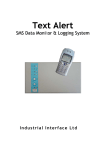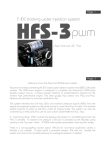Download IIR - 4002 - ALM - Industrial Interface
Transcript
4002-ALM USER MANUAL
4002 – ALM
DUAL TRIP AMPLIFIER
WITH RE-TRANSMITTED OUTPUT
Whilst every effort has been taken to ensure the accuracy of this document, we accept no responsibility
for damage, injury, loss or expense resulting from errors or omissions, and reserve the right of
amendment without notice.
Industrial Interface Ltd
This document is issued by Industrial Interface Ltd and may not be reproduced in any way without the
prior written permission of the company.
IIG-9506-04
Page 1
4002-ALM USER MANUAL
CONTENTS
1.0
INTRODUCTION
3
2.0
UNPACKING
6
3.0
CONNECTIONS
6
4.0
TRIP CONFIGURATION
8
5.0
INPUT RECONFIGURATION AND CALIBRATION
11
(APPLIES TO RE-CONFIGURABLE INPUT UNITS ONLY)
6.0
OUTPUT RECONFIGURATION AND CALIBRATION
13
(APPLIES TO RE-CONFIGURABLE OUTPUT UNITS ONLY)
7.0
SETTING TRIP POINTS
14
8.0
INSTALLATION
15
9.0
SPECIFICATIONS
17
Industrial Interface Ltd, Signal House, Unit 15, Alstone Lane Trading Estate
Alstone Lane, Cheltenham, Gloucestershire, GL51 8HF
Tel: 01242 251794, Fax: 01242 571683
www.industrialinterface.co.uk
Page 2
IIG-9506-04
4002-ALM USER MANUAL
1.0
INTRODUCTION
The 4002-ALM range is a family of configurable trip amplifiers capable of accepting a wide variety of electrical
input types, providing two trip action relay outputs and, if required, an isolated retransmission signal.
The family comprises three different products each accepting an input from a different type of sensor. Input signal,
output signal, trip configuration and power supply information are required to define any unit exactly. This
information, together with a unique serial number is printed on the side label of each unit; records of the exact
configuration of every product shipped are maintained at the factory.
Input Types And Ranges:
1.1
1.1.1
4002-ALM-HL
Accepts either DC voltage or current (i.e. high level) inputs.
In general the limits on signals that can be handled with the accuracy specified in section 8 are:
FULL SCALE INPUT
DC CURRENT
DC VOLTAGE
MIN
50µA
100mV
MAX
10A
MIN SPAN
50% FULL SCALE
NOTES
MAX VOLTAGE DROP = 0.33V
300V
50% FULL SCALE
10K ohm ≤ R in ≤ 10M ohm
USE 4002-TC FOR Vin<100mV
All the standard process ranges such as 0-10mA, 4-20mA, 0-20mA, 1-5V and 0-10V are of course covered.
1.1.1.1
Reconfigurable input option
A user reconfigurable input version of the product can be specified, covering 0-20mA, 4-20mA and 0-10V
inputs (see section 5).
1.1.2
4002-ALM-TC
Accepts inputs directly from the following thermocouple types: J, K, N, T, R, B, E, U, L and S. Alternatively a
mV input may be specified.
All specified ranges are zero referred - i.e. 0°F, 0°C or 0mV, although negative inputs will not damage the unit.
Automatic cold junction compensation will be fitted to thermocouple units, for which either upscale or
downscale drive on break detection are link selectable (see section 4) - factory default setting is upscale. The
process signal is not linearised. For standard thermocouples the operating range will be specified in °C or °F,
as required.
In general, the limits on signals that can be handled with the accuracy specified in section 8 are:
FULL SCALE INPUT
mV
J (L)
MIN
4mV
MAX
100mV
80°C
1200°C
K
100°C
1372°C
IIG-9506-04
T (u)
95°C
400°C
E
65°C
1000°C
N
150°C
1300°C
R
460°C
1768°C
S
480°C
1760°C
B
910°C
1820°C
NOTES
COLD JUNCTION COMPENSATION WILL
NOT BE FITTED
Page 3
4002-ALM USER MANUAL
1.1.2.1
Reconfigurable input option.
A reconfigurable version of the product is not currently available, although upscale or downscale burnout is
user selectable.
1.1.3
4002-ALM-RTD
Accepts inputs from resistance thermometers such as the PT100 type in 2 or 3 wire configuration. Additionally
2 wire potentiometers less than 1K ohm can be accommodated.
In general the measured resistance can be anywhere between zero and 1Kohm and standard curves such as
PT100 can be linearised. The minimum span must be 10 ohm for the accuracy specified in section 8, which
corresponds to roughly 30°C for a PT100 sensor. For standard RTD sensor types, the operating range will be
specified in °C and the process signal will be linearised; otherwise the range will be specified in ohms without
linearisation. 2 or 3 wire connection is link selectable (see section 4) - factory default setting is 3 wire.
Downscale drive on wire break detection is standard - upscale drive can be specially requested from the factory
but is only possible with a 2 wire connection.
1.1.3.1
Reconfigurable input option
A user reconfigurable input version of the product can be specified covering any 4 RTD / resistance
combinations (see section 5).
1.2
Output types & ranges
If required, any 4002-ALM unit can be fitted with a retransmission output board with the following standard ranges:
i)
ii)
iii)
iv)
0-1V
0-10V
0-20mA current source
4-20mA current source
Other ranges are possible - please consult Industrial Interface if required.
1.2.1
Reconfigurable output option
A user reconfigurable output version of the product can be specified covering all of the above standard ranges (see
section 6).
1.3
Power supply
1.3.1
Low voltage DC version
Standard power supply requirement is for 24V dc ±10% for specified performance. 5V dc, 12V dc & 24V ac
supplies can be catered for by special request - please consult Industrial Interface if required.
Unit specification
No retransmission; No transmitter supply; No display
Additional requirement for current source output
Additional requirement for buffered voltage source output
N.B.
Page 4
I supply max.
50mA
}
{
Either / or
}
{
+50mA
+70mA
Additional requirement for transmitter supply
+40mA
Additional requirement for LED display
+50mA
This unit is internally protected by a resetting fuse and zener clamp
IIG-9506-04
4002-ALM USER MANUAL
1.3.2
Mains voltage a.c. version.
Standard power supply requirement is for 240V ac ±10% or 115v ac ±10%.
The voltage is preset at the factory, though a selector switch is fitted internally. Max power consumption is 4VA.
N.B.
This unit is internally protected by a transient absorbing varistor and a 100mA quick blow fuse.
1.4
Description of operation
The input stage of the 4002 ALM produces an internal process signal of 0 - 10V DC corresponding to the input
span. This signal can be measured between the front panel test pins of the unit, with the selector switch in the centre
(process) position..
The trip set point potentiometers produce set point signals of 0 - 10V DC corresponding to the input span. These
signals can be measured between the front panel test pins of the unit, with the selector switch in the upper (set 1) or
lower (set 2) position.
Internal circuitry compares the process signal with each of the set point levels and changes the state of the output
relays and indicator LED’s as the signal passes through the set point, the exact action being factory or user
configurable (see section 4).
A hysteresis band (typically 1% of span unless specifically requested) around each set point ensures chatter-free trip
operation.
A block schematic diagram of the 4002-ALM is shown in Figure 1.
Power input
Optional display
Optional Transmitter Supply
+
14
13
+
25
10
I/V
RTD
24
2
4002-ALM
t/c
11
mA/V
Trip Amplifier
12
1
Input Isolation
Output Isolation
15
16 17
Relay 1
18
Optional Retransmission
19 20
Relay 2
FIG. 1 - BLOCK SCHEMATIC DIAGRAM FOR THE IIR-4002-ALM TRIP AMPLIFIER
IIG-9506-04
Page 5
4002-ALM USER MANUAL
2.0
UNPACKING
Please inspect the instrument carefully for signs of shipping damage. The unit is packaged to give maximum
protection but we can not guarantee that undue mishandling will not have damaged the instrument. In the case of
this unlikely event, please contact your supplier immediately and retain the packaging for our subsequent inspection.
2.1
Checking the Unit Type
Each unit has a unique serial number label on which full details of the configuration are given (see Figure 2 for
example). These details should be checked to ensure conformance with your requirement.
Fig. 2 - Serial Number Label
3.0
CONNECTIONS
This section details the instrument connection information. Relay & power connection details are also shown on the
serial number label on each unit (see figure 2). Input & output connection details are shown on the front panel (see
figure 3).
Fig. 3 - 4002-ALM 'Terminal' & 'Display' Front Panel Connection Details
Page 6
IIG-9506-04
4002-ALM USER MANUAL
3.1
Power Supply
The power supply is connected into terminals 24 (negative) and 25 (positive). The supply voltage is indicated on the
serial number label (Figure 2)
APPLICATION OF VOLTAGES HIGHER THAN THAT STATED FOR THE SUPPLY MAY CAUSE
DAMAGE TO THE INSTRUMENT.
3.2
Sensor Connections
All sensor connections are made to terminals numbered 10,11 & 12 on the instrument.
The inputs are connected as described below.
3.2.1
DC Voltage Inputs
This applies to the high level input device only (IIR-4002-ALM-HL). The signal should be connected between
terminals 11 (positive) and 10 (negative).
3.2.2
DC Current Inputs
This applies to the high-level input device only (IIR-4002-ALM-HL). The signal should be connected between
terminals 11 (positive) and 10 (negative). If the transmitter supply option is fitted, *connect transmitter positive
to terminal 14, transmitter negative to terminal 11 and link terminals 10 & 13.*
3.2.3
Thermocouple Inputs
This applies to the thermocouple input device only, (IIR-4002-ALM-TC). Thermocouples or mV sources are
connected to input terminals 10 (negative) and 11 (positive). The cold junction compensation, where
appropriate, is performed by an integral sensor located close, and thermally connected to, the input terminal.
3.2.4
RTD Inputs
This applies to the resistance thermometer input device only, (IIR-4002-ALM-RTD). RTD’s should be
connected using three identical wires in order that measurement errors due to lead wire resistances can be
eliminated. The sensor common wires should be connected to terminals 10 & 12, the remaining wire going to
terminal 11. If it is necessary to use a two wire sensor then it should be connected between terminals 10 and 11
and an internal link should be fitted (see section 4.0 Trip Configuration); alternatively terminals 10 & 12 can be
externally linked.
*
2 wire transmitter
IIG-9506-04
Page 7
4002-ALM USER MANUAL
4.0
TRIP CONFIGURATION
4.1
Standard (non latching) operation
The action of each trip can be simply described by considering the state of the relevant relay and LED indicator with
process signal either side of the trip set point. The options for each trip are as follows:
a)
Relay energised for process signal above set
LED on for process signal above set point
point
b) Relay energised for process signal above set
LED off for process signal above set point
point
c) Relay energised for process signal below set
LED on for process signal below set point
point
d) Relay energised for process signal below set
LED off for process signal below set point
point
Thus any combination of fail safe or non fail safe options can be catered for.
4.1.2
Factory Pre-Configured Units
Where the unit is required for a preset trip configuration this can be requested at time of order and will be
carried out free of charge at the factory. In this case the following convention, corresponding to option a to d
above, is used for specifying operation:
a)
b)
c)
d)
RLY x > SP x < LED x
RLY x > SP x > LED x
RLY x < SP x > LED x
RLY x < SP x < LED x
Where
x
x
= 1 for trip 1
= 2 for trip 2
This information will appear on the serial number side label on pre-configured units (figure 2). It is helpful if
this convention is used by the customer when specifying units.
4.1.3
Default Configuration
In the event that pre-configuration information is not available, units will be shipped in default configuration as
follows:
RLY 1 > SP 1 < LED 1
RLY 2 < SP 2 > LED 2
4.1.4
(case a, section 4.1)
(case c, section 4.1)
User Configuration
If it is necessary to change the trip action of the instrument, or to change the wire break detection (4002-ALMTC only) or 2/3 wire sensor connection (4002-ALM-RTD only), the two halves of the plastic enclosure must be
separated. This is achieved by using a fine bladed screwdriver as follows:
Place the blade in each of the seven slots in turn in the wide half of the enclosure (the half with the serial
number label attached), holding the blade flat towards the outside of the unit - whilst levering the screwdriver
handle towards the outside of the unit thereby releasing the catch, gently prise apart the two halves of the casing
with the thumb and forefinger on the other hand. This procedure is best carried out starting with the slot at the
top right hand corner of the side label and working anti-clockwise around the remaining slots.
The trip action of the unit may then be configured by changing the handbag links with reference to figure 4.
Wire break detection (4002-ALM-TC only) and 2/3 wire sensor connection (4002-ALM-RTD only) link
settings are shown in section 5.
Page 8
IIG-9506-04
4002-ALM USER MANUAL
Fig. 4 - 4002-ALM Mother board Link Settings
L8
L7
1
1
2
2
L6
1
1
2
2
L5
L9
L4
L3
1
2
1
2
L2
L1
1
1
2
2
LINK SET NO
POSITION
FUNCTION DESCRIPTION
Links 1 and 2
1
Relay 1 energised Above Setpoint
Links 1 and 2
2
Relay 1 energised Below Setpoint
Links 3 and 4
1
Relay 2 energised Below Setpoint
Links 3 and 4
2
Relay 2 energised Above Setpoint
Links 5 and 6
1
LED1 Off when Relay 1 energised
Links 5 and 6
2
LED1 On when Relay 1 energised
Links 7 and 8
1
LED2 On when Relay 2 energised
Links 7 and 8
2
LED2 Off when Relay 2 energised
Link 9
fitted
Relay Latching Function
IIG-9506-04
Page 9
4002-ALM USER MANUAL
4.2
Latching Operation
Latching operation of relay 1 can be achieved by connecting link 9. Note that, where latching operation is specified,
trip set point 2 is used to set the unlatch threshold such that Relay 2 is not independent. Latching operation is not
possible with relay 2.
With Link 9 fitted, Relay 1 can be set to energise when the process signal rises above or falls below trip set point 1,
in the normal fashion. At the same time LED 1 can be set to be on above or below set point 1. Once relay 1 has
become energised it will remain energised so long as either the initial condition which caused the trip is sustained,
or whilst relay 2 is de-energised, or both. i.e. relay 1 can only be latched whilst relay 2 is de-energised and can only
be unlatched whilst relay 2 is energised. (Note that LED1 denotes whether the process signal is above or below trip
set point 1, not whether relay 1 is energised.)
By way of example the latching mode of operation is likely to be used to maintain the process signal between an
upper and a lower limit (for instance tank level control) as shown in Figure 5:
}HYSTERESIS
BAND
SET POINT 2
ROCESS SIGNAL
}HYSTERESIS
BAND
SET POINT 1
RELAY 1
EN
EN
RELAY 2
ON
LED 1
ON
LED 2
Fig. 5 - Timing Diagram - Latching Operation Of 4002-ALM
Trip 1 is set to option d) (section 4.1)
Trip 2 is set to option b) (section 4.1)
Trip set point 1 is set to the lower allowable limit
Trip set point 2 is set to the upper allowable limit
When the process signal is below set point 1 relay 1 is energised (latched) and will remain energised until the
signal reaches set point 2. At this point relay 1 is unlatched (by relay 2 energising). As the process signal
reduces relay 2 de-energises. As the signal falls below set point 1 relay 1 is energised (latched) again and the
cycle repeats.
The LEDs can be used to indicate the status as follows:
LED1
LED2
STATUS
OFF
OFF
Power Fail
OFF
ON
At or below bottom unit
ON
OFF
At or above top limit
ON
ON
Within limits
Page 10
IIG-9506-04
4002-ALM USER MANUAL
5.0
INPUT RECONFIGURATION (RECONFIGURABLE INPUT UNITS ONLY) AND CALIBRATION
If the 4002-ALM has a reconfigurable input option, reconfiguration can be carried out by changing handbag links
on the input daughter board and, for greatest accuracy, recalibrating the 0-10V process signal.
5.1
4002-ALM-HL Reconfiguration and Calibration
(i)
(ii)
iii)
Referring to 4002-ALM-HL link setting diagram (figure 6), set links 1 through 4 as required.
Connect voltmeter between front panel terminals and set selector switch to centre (process) position.
Connect a current or voltage source as appropriate to input terminals 10
(-ve) and 11 (+ve)
(iv) Adjust VR2 (located towards rear of daughter board) to give 0.00V on voltmeter at zero scale for 4-20mA
range only - zero is automatic for other ranges
(v) Adjust VR1 (located towards front of daughter board) to give 10.00V on voltmeter at full scale
(vi) Repeat (iv) and (v) as necessary.
N.B. If unit has LED display option fitted, a voltmeter is not necessary - instead adjust VR2 for 0% and VR1 for
100% readings respectively.
5.2
4002-ALM-TC Reconfiguration and Calibration
(i) Referring to 4002-ALM-TC link setting diagram (figure 7), set link 9 to the appropriatte sensor burnout action.
(ii) Connect voltmeter between front panel terminals and set selector switch to centre (process) position.
(iii) Ensuring that the cold junction compensation temperature is equal to
the 4002-TC terminal temperature, connect a thermocouple simulator
to terminals 10 (-ve) and 11 (+ve)
(iv) Adjust VR2 (located towards rear of daughter board) to give 10.00V on voltmeter at full scale
N.B. Do not adjust VR1 (located towards front of daughter board). This is for servicing purposes only.
5.3
4002-ALM-RTD Reconfiguration and Calibration
(i)
Referring to the 4002-ALM-RTD link setting diagram (figure 8), select range 1, 2, 3 or 4, as detailed on unit
side label, as follows:
RANGE
1
2
3
4
LINKS FITTED
1, 5, 9
2, 6, 10
3, 7, 11
4, 8, 12
(ii) Connect voltmeter between front panel terminals and set selector switch to centre (process) position.
(iii) Ensuring that lead resistance is minimised (2 wire connection) or equal (3 wire connection), connect an RTD
simulator or resistance box to terminals 10 and 11, and in the 3 wire case 12 also.
(iv) Adjust VR2 (single turn potentiometer located towards front of daughter board) to give 10.00V on voltmeter at
full scale
(v) Adjust VR1 (multi-turn 10v potentiometer on daughter board) to give 0.00V on voltmeter at zero scale.
(vi) Repeat (iv) and (v) as necessary
(vii) Check for voltmeter reading of 5.00V at half scale input
IIG-9506-04
Page 11
4002-ALM USER MANUAL
Fig. 6 - 4002-ALM-HL Input Board Link Settings
L1 L2
1 1
L4
2 2
1
2
L3
INPUT
0-10V
0-20mA
4-20mA
L1
1
2
2
L2
1
2
2
L3
Not Fitted
Fitted
Not Fitted
L4
2
2
1
Fig. 7 - 4002-ALM-TC Input Board Link Settings
L9
1
2
LINK N0.
9
9
POSITION
1
2
FUNCTION DESCRIPTION
Upscale Burnout
Downscale Burnout
Fig. 8 - 4002-ALM-RTD Input Board Link Settings
L13
L1 L2 L3 L4
INPUT
RTD Range 1
RTD Range 2
RTD Range 3
RTD Range 4
SENSOR CONNECTION
2 Wire
3 Wire
Page 12
L5 L6 L7 L8
L9 L10 L11 L12
L1, L5 & L9 Fitted
L2, L6 & L10 Fitted
L3, L7 & L11 Fitted
L4, L8 & L12 Fitted
L13 Fitted
L13 Not Fitted
IIG-9506-04
4002-ALM USER MANUAL
6.0
OUTPUT RECONFIGURATION (RECONFIGURABLE OUTPUT UNITS ONLY) AND CALIBRATION
If the 4002-ALM has signal retransmission (optional) and has a reconfigurable output option, reconfiguration can be
carried out by changing handbag links on the output daughter board and recalibrating the output signal:
(i)
Refering to 4002-ALM-OP link setting diagram (figure 9), set links 1 to 7 as required.
(ii)
With appropriate zero scale signal input to the unit (which should result in a voltage of 0.00v on the front panel
terminals with the selector switch in the centre (process) position), adjust the output zero potentiometer VR1
(located at the top of the Output daughter board) for the appropriate zero scale output value.
(iii)
With appropriate full scale signal input to the unit (which should result in a voltage of 10.00v on the front panel
terminals with the selector switch in the centre (process) position), adjust the output span potentiometer VR2
(located at the bottom of the Output daughter board) for the appropriate full scale output value.
N.B. Current output units are factory calibrated into 250ohm load.
(iv)
Repeat steps (ii) and (iii) as necessary.
Fig. 9 - 4002-ALM Output Board Link Settings
L6 L7
L5
L1
L2
L3
OUTPUT TYPE
L1
L2
L4
L5
L6
L7
0-1V
0-10V
0-20mA
4-20mA
N.B. Links 3 & 4 are factory fitted where output signal isolation is not required
IIG-9506-04
Page 13
4002-ALM USER MANUAL
7.0
SETTING TRIP POINTS
The trip points can be measured between the front panel terminals with the selector switch in the appropriate
position. The measured signal is a voltage between 0 and 10V corresponding to the input range of the unit. If the
LED display option is fitted, a 0-100% reading is obtained.
7.1
4002-ALM-HL Trip Points
Since the 0-10V process signal is linear for this device the trip point is equal to 100% of span multiplied by the set
point voltage
e.g.
4-20mA input
trip at 16mA input = 75% of span
therefore trip set point = 7.5V
7.2
4002-ALM-TC Trip Points
Since the 0-10V process signal is linear with respect to thermocouple voltage and not degrees, the set point must be
calculated as follows:
(i)
Look up full scale thermocouple millivolts from table - X
(ii)
Look up millivolt output for required trip point - Y
(iii) Set 0-10V indication for Y/X volts
1200°C = 48.828mV
e.g. a) 0-1200 ° C type K
900 ° C = 37.325mV
b) Require trip above 900 ° C;
37.325 x 10v
= 7.64V
c) Set point will be
48.828
Unit will then trip on at 900 ° C and off at (900 - Z) ° C, where Z is hysteresis band. (Hysteresis is typically 1% of
span, unless otherwise specified)
7.3
4002-ALM-RTD Trip Points
Since the 0-10V process signal is linear for this device the trip point is equal to 100% of span multiplied by the set
point voltage
e.g.
Page 14
-100 to 200°C PT 100 input
trip at 100°C = 67% of span
therefore trip set point = 6.7V
IIG-9506-04
4002-ALM USER MANUAL
8.0
INSTALLATION
Fig. 10 - Installation Data & Terminal Positions For 4002-ALM
Installation Data___________________
Mounting
DIN Rail TS35/TS32
Orientation
Any (Vertical Preferred)
Connections
2 Part Screw Clamp With Pressure Plate
Conductor Size
0.5mm - 4.0 mm
Insulation Stripping
6mm
Screw Terminal Torque
0.4Nm Max.
Weight
210g (approx.) d.c. supply
360g (approx.) a.c. supply
IIG-9506-04
Page 15
4002-ALM USER MANUAL
8.1
Installation onto Rails
The instrument is designed to mount directly onto either the 'G' TS32 standard assembly rail (to DIN 46277
part1/EN50035/BS5825), or the "Top hat" TS35 standard assembly rail (to DIN46277 part 3/EN 50022/BS5584).
The specially designed enclosure incorporates a universal foot assembly which uses the elastic properties of the
moulded material to form a spring clip.
8.2
Mounting Arrangements
Ideally the unit should be mounted in a vertical position, i.e. on a horizontal rail. This is the optimum orientation to
minimise temperature rise within the unit. However successful operation is possible in any orientation.
Ensure the maximum ambient temperature is less than 55°C.
Good airflow around the unit will maximise reliability.
8.3
Wiring Precautions
These units can accept a variety of sensor inputs, some of which produce very small voltages. Therefore it is
advisable to adhere to the following rules of good installation practice:
(i)
Do not install close to switchgear, electromagnetic starters, connectors, power units or motors.
(ii)
Do not have power or control wiring in the same loom as sensor wires.
(iii)
Use screened cable for sensor wiring with the screen earthed at one end only.
(iv)
Take care not to allow cut pieces of wire to fall onto the unit as they might enter via the ventilation holes
and cause electrical short circuits. If in doubt, remove the units from the rail until wiring is complete.
(v)
Use bootlace ferrules on all bare wires.
IMPORTANT:
Page 16
The connection terminals are designed for a maximum torque of 0.4Nm. Exceeding this
figure is unnecessary and will result in unwarrantable damage to the unit.
IIG-9506-04
4002-ALM USER MANUAL
9.0
SPECIFICATIONS
All specifications are at 20 ° C operating ambient with 250ohm output load (current output) unless otherwise stated.
9.1
9.1.1
9.1.2
Input / Trip Accuracy and Response
4002-ALM-HL
Process signal linearity
+/- 0.1% full scale
Trip point accuracy
+/- 0.25% range
Hysteresis
-1% full scale standard
Process signal drift
+/- 100ppm full scale/°C
Trip point drift
+/- 100ppm/°C
Signal Response Time (90% of step change)
2ms typical
Relay response time
10ms typical
4002-ALM-TC
Process signal linearity (with respect to thermocouple
+/- 0.1% full scale
voltage)
9.1.3
Trip point accuracy
+/- 0.25% range
Hysteresis
-1% full scale standard
span ≥ 10mV
-2% full scale standard
span < 10mV
Cold junction compensation accuracy
+/- 2°C over operating temperature range0-5°C
Process signal drift
+/- 100ppm full scale/°C
Trip point drift
+/- 100ppm/°C
Signal response time (90% of step change)
300ms typical
Relay response time
10ms typical
4002-ALM-RTD
Process signal linearity
+/- 0.1% range
Trip point accuracy
+/- 0.25% range
Hysteresis
- 1% full scale standard
span ≥ 10Ω
-2% full scale standard
span < 10Ω
Process signal drift
+/- 100ppm full scale/° C
Trip point drift
+/ 100ppm/° C
Signal response time (90% of step change)
10ms typical
Relay response time
10ms typical
IIG-9506-04
Page 17
4002-ALM USER MANUAL
9.2
9.3
Retransmit Output Accuracy and Response (with respect to 0-10v process signal, all types)
Calibration accuracy at zero & full scale
+/- 0.05% full scale
Linearity
+/- 0.1% full scale
Zero drift
+/- 50ppm full scale / °C
Gain drift
+/- 100ppm / °C
Gain dependance on load resistance, RL
-10ppm / W, 0 £ RL £ 750W
Response time (90% of step change)
30mS typical
Power Supply Isolation and Operating Ambient (all 24v d.c. types)
Operating Voltage
24V DC +/- 10%
Current consumption *
100mA typical (dependent on configuration)
Input to output to power supply isolation
1kV DC
Input, output and power supply to relay contact
isolation
2kV RMS AC
Operating temperature range
0-55°C
Storage temperature range
-40 - 100°C
Operating and storage humidity range
0 - 90% RH
* Both relays energised, overscale re-transmission, no transmitter supply or LED display
9.4
EMC Performance
EMC
LVD Standards
Installation Category (IEC 664)
Pollution Degree (EN61010-1)
Equipment Class (IEC 536)
Page 18
BS EN61326
EN61010-1
II
2
II
IIG-9506-04































